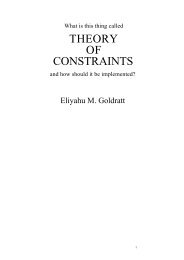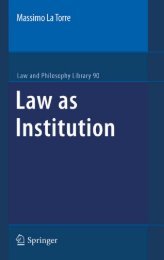Making of a German Constitution : a Slow Revolution
Making of a German Constitution : a Slow Revolution
Making of a German Constitution : a Slow Revolution
You also want an ePaper? Increase the reach of your titles
YUMPU automatically turns print PDFs into web optimized ePapers that Google loves.
66 • The <strong>Making</strong> <strong>of</strong> a <strong>German</strong> <strong>Constitution</strong>he received from the Neuraths, this still must have been an emotionally challengingtime for him.War in the Rhineland<strong>Revolution</strong> came to France, violently, in 1789, and despite the initial renunciation<strong>of</strong> international wars, for a number <strong>of</strong> reasons, France and the <strong>German</strong> states werebound to wind up in conflict. Austrophobia fed the revolutionaries’ fears <strong>of</strong> the ForeignPlot. Lavicomterie de Saint-Samon’s Les crimes des empereurs d’Allemagnedepuis Lothar I jusqu’à Léopold II (1793) reflected the fever level <strong>of</strong> Austrophobiain France. As Thomas Kaiser writes, the Hapsburgs were accused <strong>of</strong> using ‘obliquemethods <strong>of</strong> conquests that traditional misogyny characterized as “feminine”, as opposedto the more honest, manly pursuit <strong>of</strong> war’. 54 According to Lavicomterie, it hadtaken centuries for the Hapsburg to perfect their contrived system <strong>of</strong> despotism. ‘Thebreakthrough’, as Kaiser points out, was alleged to have ‘occurred as a result <strong>of</strong> thePragmatic Sanction under Charles VI, which allowed women, in particular MariaTheresa, to come to the throne and thereby to deploy to maximum effect the peculiarfeminine methods devised by the Hapsburg’s for their aggrandizement.’ 55 Havingusurped authority from her husband, Maria Theresa amongst other schemes had allegedlygroomed her children to carry forward her programme <strong>of</strong> European domination.56 Her daughter, the hated Queen Marie Antoinette, who was charged with tryingto rule France according to the wishes <strong>of</strong> her family, had become the symbol <strong>of</strong> thisForeign Plot and was the embodiment <strong>of</strong> oblique conquest. In Vienna, EmperorsJoseph II (r. 1765–1790) and Leopold II (r. 1790–1792) were the siblings <strong>of</strong> the illfatedMarie Antoinette. After Leopold’s death, her nephew Francis II (r. 1792–1832)inherited the throne <strong>of</strong> the Holy Roman Empire.In the Rhineland, regardless <strong>of</strong> reform impulses, the Rhenish princes with theirpompous titles and tiny territories symbolized the decadence <strong>of</strong> ancient regime Europein the minds <strong>of</strong> French revolutionaries. Elector Clemens Wenzeslaus von Sachsenwas not only Louis XVI’s uncle, but, worse, allowed his court in Koblenz tobecome a centre for counter-revolutionary ferment. The elector <strong>of</strong> Mainz as wellas Cardinal Rohan <strong>of</strong> Straßburg also opened their territories to thousands <strong>of</strong> royalistémigrés, who readily formed themselves into militias. Although some electorswould later order the disarming and dispersal <strong>of</strong> such units, the damage could not beundone. Matters were complicated further by the question <strong>of</strong> what to do about nobleprivileges and territorial rights granted to <strong>German</strong> princes resident in Alsace, by thedeposed French monarchy. A report <strong>of</strong> the Constituent Assembly soon proclaimedthat, since the French people had not consented to such privileges, they were invalidand the people were not obliged to compensate for any losses. 57These various matters along with the intrigues <strong>of</strong> a group <strong>of</strong> multinational exilesin Paris combined to lend support to the war hawks in the Girondists-dominated




